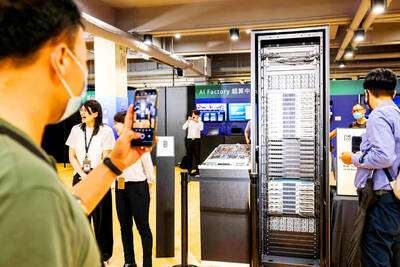NTT Docomo Inc yesterday led a ¥3.8 trillion (US$33.6 billion) stock rout of Japan’s top three mobile carriers after it appeared to cave in to pressure from the government, which has long claimed that the nation’s phone bills are among the highest in the world.
Docomo, which on Wednesday said it might cut rates by 40 percent and “return” ¥400 billion to customers, plunged as much as a record 15 percent in Tokyo trading.
Rival KDDI Corp tumbled as much 17 percent, and Softbank Group Corp slumped as steeply as 9.1 percent amid concern that they would follow suit.
Docomo’s plan to cut mobile rates in the year starting on April 1 sparked concern that industry profits could slump for years, exacerbating investor anxiety over a market that is already plagued by saturation and increasing competition.
The move comes after the government, particularly Japanese Chief Cabinet Secretary Yoshihide Suga, repeatedly called for carriers to reduce phone bills.
“What surprised investors is Docomo will take about five years to recover above the profit level for the current fiscal year,” said Naoki Fujiwara, chief fund manager for Shinkin Asset Management Co in Tokyo. “Other major mobile carriers may have little choice but to follow Docomo with price cuts.”
Docomo’s warning on Wednesday that the firm would offer plans starting on April 1 that would lower rates by 20 to 40 percent overshadowed the announcement that it would repurchase as much as 7.24 percent of its stock for ¥600 billion to help drive up shareholder returns. It said it would consider canceling all the shares it buys back.
KDDI president Makoto Takahashi yesterday said the company would not follow Docomo’s price cuts. He said the company had already introduced lower rates.
Softbank said it was considering its pricing based on competition and user needs.
The latest round of comments by government officials began in August, when Suga said carriers have room to cut bills by 40 percent.
In response, investors lopped more than US$14 billion off the combined market value of the three big carriers over two days. The shares had fully recovered from that plunge, only to plummet yesterday.
Japanese carriers are a big part of the Nikkei 225 Stock Average, with the big three accounting for 6.7 percent of the index’s weighting.
The benchmark fell 1.1 percent yesterday.

LIMITED IMPACT: Investor confidence was likely sustained by its relatively small exposure to the Chinese market, as only less advanced chips are made in Nanjing Taiwan Semiconductor Manufacturing Co (TSMC, 台積電) saw its stock price close steady yesterday in a sign that the loss of the validated end user (VEU) status for its Nanjing, China, fab should have a mild impact on the world’s biggest contract chipmaker financially and technologically. Media reports about the waiver loss sent TSMC down 1.29 percent during the early trading session yesterday, but the stock soon regained strength and ended at NT$1,160, unchanged from Tuesday. Investors’ confidence in TSMC was likely built on its relatively small exposure to the Chinese market, as Chinese customers contributed about 9 percent to TSMC’s revenue last

With this year’s Semicon Taiwan trade show set to kick off on Wednesday, market attention has turned to the mass production of advanced packaging technologies and capacity expansion in Taiwan and the US. With traditional scaling reaching physical limits, heterogeneous integration and packaging technologies have emerged as key solutions. Surging demand for artificial intelligence (AI), high-performance computing (HPC) and high-bandwidth memory (HBM) chips has put technologies such as chip-on-wafer-on-substrate (CoWoS), integrated fan-out (InFO), system on integrated chips (SoIC), 3D IC and fan-out panel-level packaging (FOPLP) at the center of semiconductor innovation, making them a major focus at this year’s trade show, according

DEBUT: The trade show is to feature 17 national pavilions, a new high for the event, including from Canada, Costa Rica, Lithuania, Sweden and Vietnam for the first time The Semicon Taiwan trade show, which opens on Wednesday, is expected to see a new high in the number of exhibitors and visitors from around the world, said its organizer, SEMI, which has described the annual event as the “Olympics of the semiconductor industry.” SEMI, which represents companies in the electronics manufacturing and design supply chain, and touts the annual exhibition as the most influential semiconductor trade show in the world, said more than 1,200 enterprises from 56 countries are to showcase their innovations across more than 4,100 booths, and that the event could attract 100,000 visitors. This year’s event features 17

Hon Hai Precision Industry Co (鴻海精密), which assembles servers for Nvidia Corp, yesterday said that revenue last month rose 10.61 percent year-on-year, driven by strong growth in cloud and networking products amid continued front-loading orders for artificial intelligence (AI) server racks. Consolidated revenue expanded to NT$606.51 billion (US$19.81 billion) last month from NT$548.31 billion a year earlier, marking the highest ever in August, the company said in a statement. On a monthly basis, revenue was down 1.2 percent from NT$613.86 billion. Hon Hai, which is also a major iPhone assembler, added that its electronic components division saw significant revenue growth last month, boosted